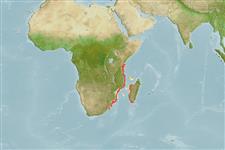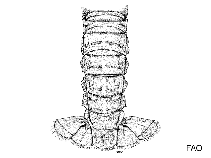Metanephrops mozambicus Macpherson, 1990
African lobster| Native range | All suitable habitat | Point map | Year 2050 |

|
| This map was computer-generated and has not yet been reviewed. |
| Metanephrops mozambicus AquaMaps Data sources: GBIF OBIS |
Classification / Names Common names | Synonyms | CoL | ITIS | WoRMS
Malacostraca | Decapoda | Nephropidae
Environment: milieu / climate zone / depth range / distribution range Ecology
Benthic; depth range 180 - 750 m (Ref. 106911), usually 400 - 500 m (Ref. 106911). Tropical, preferred 26°C (Ref. 107945); 3°S - 33°S, 31°E - 46°E (Ref. 4)
Distribution Countries | FAO areas | Ecosystems | Occurrences | Introductions
Southwest Atlantic and Indo-West Pacific: from Kenya to Natal.
Length at first maturity / Size / Weight / Age
Maturity: Lm 4.9, range 3 - ? cm Max length : 20.5 cm TL male/unsexed; (Ref. 122061); 20 cm TL (female)
It has a maximum total length of 20.5 cm (male) and 20 cm (female); and carapace lengths of 4.5 to 8.8 cm (male) and 3.7 to 8.3 (female). Minimum depth range from Ref. 122059. Occurs at depths from 200 to 750 m, but most common between 400 and 500 m (Ref. 4). Occurs along the edge of the continental slope on soft muddy substrata (Ref. 106911).
Life cycle and mating behavior Maturity | Reproduction | Spawning | Eggs | Fecundity | Larvae
Ovigerous females between December and June (Ref. 4).
Main reference
References | Coordinator | Collaborators
Holthuis, L.B. 1991. (Ref. 4)
IUCN Red List Status (Ref. 130435)
Least Concern (LC) ; Date assessed: 03 December 2009
CITES status (Ref. 108899)
Not Evaluated
CMS (Ref. 116361)
Not Evaluated
Threat to humans
Human uses
Fisheries: commercial
FAO - Fisheries: landings | FishSource | Sea Around Us
Tools
More information
Age/Size
Growth
Length-weight
Length-length
Morphology
Larvae
Abundance
Growth
Length-weight
Length-length
Morphology
Larvae
Abundance
Internet sources
BHL | BOLD Systems | CISTI | DiscoverLife | FAO(Fisheries: ; publication : search) | Fishipedia | GenBank (genome, nucleotide) | GloBI | Gomexsi | Google Books | Google Scholar | Google | PubMed | Tree of Life | Wikipedia (Go, Search) | Zoological Record
Estimates based on models
Preferred temperature
(Ref. 115969): 10 - 12.3, mean 11.4 (based on 9 cells).
Resilience
(Ref. 69278):
High, minimum population doubling time less than 15 months (K=0.45-0.48).
Nutrients: Calcium = 109 [35, 184] mg/100g; Iron = 1.59 [1.21, 1.97] mg/100g; Protein = 20.2 [19.2, 21.3] %; Omega3 = 0.285 [0.185, 0.386] g/100g; Selenium = 48.3 [-31.7, 128.3] μg/100g; VitaminA = 0 μg/100g; Zinc = 1.79 [1.17, 2.40] mg/100g (wet weight).



